
PC software pioneer Gary Kildall demonstrated CP/M, the first commercially successful personal computer operating system in Pacific Grove, California, in 1974. Following is the story of how his company, Digital Research Inc., established CP/M as an industry standard and its subsequent loss to a version from Microsoft that copied the look and feel of the DRI software.
Gary Arlen Kildall was born to a family of Scandinavian descent in Seattle, Washington, in 1942. His inventive skills flourished in repairing automobiles and having fun but suffered in scholastic pursuits. He qualified for admission to the University of Washington based on his teaching experience at the family-owned Kildall Nautical School rather than his high school grades.

Dorothy and Gary, circa 1978. Photo: Courtesy Kildall Family
Gary entered college and married his high school sweetheart Dorothy McEwen in 1963. He was one of 20 students accepted into the university's first master's program in computer science. Here, his mathematical talents were applied to a subject that fascinated him: all-night sessions programming a new Burroughs computer. To avoid the uncertainty of the draft at the height of the Vietnam War, on graduating with a PhD, he entered a US Navy officer training school and was posted to serve as an instructor in computer science at the Naval Postgraduate School (NPS) in Monterey, California.

Herrmann Hall, Naval Postgraduate School, Monterey. Creative Commons CC0 1.0 Universal Public Domain Dedication.
Gary remained at NPS as an associate professor after his tour of duty ended in 1972. He became fascinated with Intel Corporation's first microprocessor chip and simulated its operation on the school's IBM mainframe computer. This work earned him a consulting relationship with the company to develop PL/M, a high-level programming language that played a significant role in establishing Intel as the dominant supplier of chips for personal computers.
To design software tools for Intel's second-generation processor, he needed to connect to a new 8" floppy disk-drive storage unit from Memorex. He wrote code for the necessary interface software that he called CP/M (Control Program for Microcomputers) in a few weeks, but his efforts to build the electronic hardware required to transfer the data failed. The project languished for a year. Frustrated, he called electronic engineer John Torode, a college friend then teaching at UC Berkeley, who crafted a "beautiful rat's nest of wirewraps, boards and cables" for the task.
Late one afternoon in the fall of 1974, together with John Torode, in the backyard workshop of his home at 781 Bayview Avenue, Pacific Grove, Gary "loaded my CP/M program from paper tape to the diskette and 'booted' CP/M from the diskette, and up came the prompt: *."
"This may have been one of the most exciting days of my life, except, of course, when I visited Niagara Falls," he exclaimed. We now have the power of an IBM S/370 [mainframe computer] at our fingertips." This is going to be a "big thing," they told each other and "retired for the evening to take on the simpler task of emptying a jug of not-so-good red wine … and speculating on the future of our new software tool."
By successfully booting a computer from a floppy disk drive, they had given birth to an operating system that, together with the microprocessor and the disk drive, would provide one of the key building blocks of the personal computer revolution. While they knew it was important, neither realized the extraordinary impact it would have on their lives and times.

781 Bayview Avenue, Pacific Grove, circa 1974. Photo: Courtesy Kildall Family
As Intel expressed no interest in CP/M, Gary was free to exploit the program on his own and sold the first license in 1975. He continued teaching part-time at NPS, and in 1976, with his wife Dorothy as cofounder, they established Intergalactic Digital Research to pursue commercial opportunities. They shortened the company name to Digital Research Inc. (DRI) when it became available.
Glenn Ewing, a former NPS student, approached DRI with the opportunity to license CP/M for a new family of disk subsystems for fast-growing microcomputer maker IMSAI Inc. Reluctant to adapt the code for another controller, Gary worked with Glen Ewing to split out the hardware dependent-portions so they could be incorporated into a separate piece of code called the BIOS (Basic Input Output System).
Before CP/M, computer manufacturers designed their operating systems to work only with their own hardware and peripheral equipment. An IBM OS would only work with IBM computers; a Burroughs OS would only work with Burroughs computers, etc. Applications had to be written for each computer's specific OS. Such "closed systems" made it difficult or impossible to mix and match the best pieces of equipment and software applications programs from different manufacturers.
The BIOS code allowed all Intel and compatible microprocessor-based computers from other manufacturers to run CP/M on any new hardware. This capability stimulated the rise of an independent software industry by expanding the market's potential size for each product. A single program could run without modification on computers supplied by multiple manufacturers, laying an essential foundation for the personal computer revolution.

DRI advertisement from 1978
Dorothy and Gary opened their first office at 716 Lighthouse Avenue, Pacific Grove, on the upper floor, with a view of Monterey Bay. They sold CP/M disks via mail order and walked to the post office every workday to pick up checks resulting from ads placed in industry magazines such as Byte and Dr. Dobbs' Journal of Computer Calisthenics and Orthodontia.
A licensing deal with computer manufacturer IMSAI bestowed credibility across the industry. CP/M became accepted as a standard and was offered by most early personal computer vendors, including pioneers Altair, Amstrad, Kaypro, and Osborne.
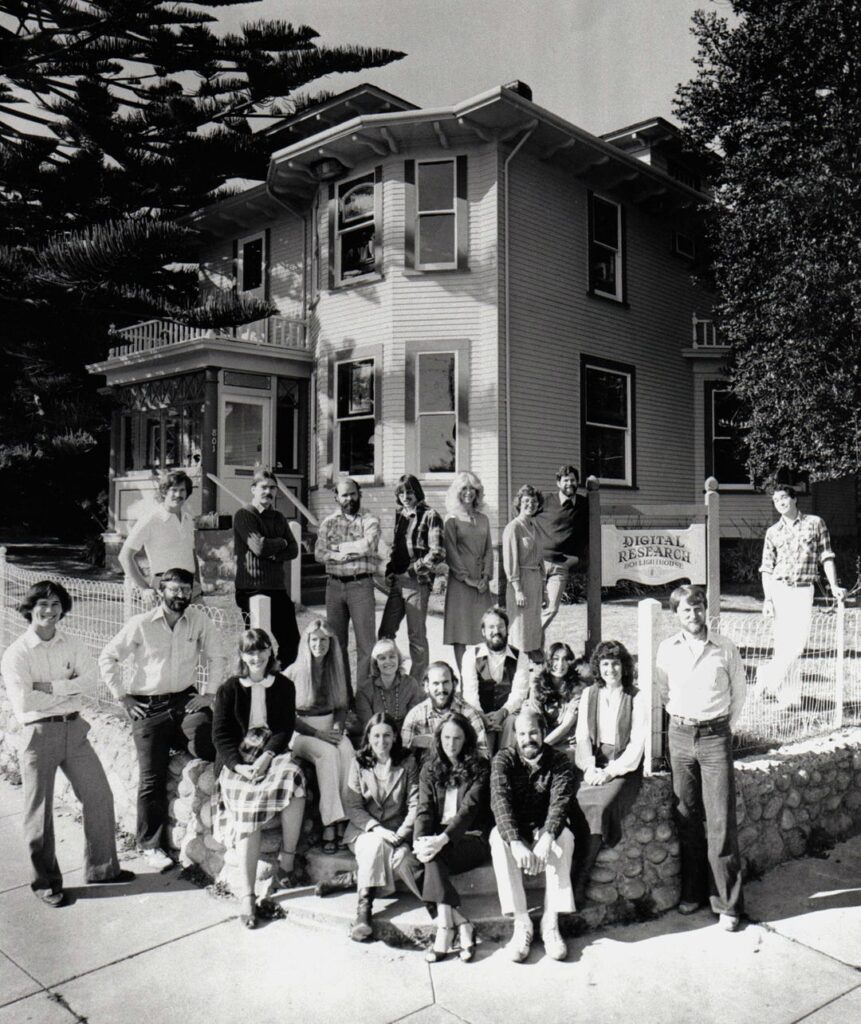
Outside the DRI office at 801 Lighthouse Avenue in November 1980. Photo: John Pierce
In 1978, revenue topped $100,00 per month, and DRI purchased a Victorian house at 801 Lighthouse Avenue for the company headquarters. By 1980, DRI employed more than 20 people, and Fortune magazine reported that the company generated revenue of $3.5 million, five times the revenue of Microsoft at that time. Gary also acquired a Piper aircraft that allowed him to fly from Monterey to meet regularly with his customers in Silicon Valley and beyond.
To accommodate the expanding engineering staff hired to service the hundreds of different computer models used by more than a million people worldwide, DRI purchased a 1909 American Foursquare-style residence at 734 Lighthouse. Today, it houses the offices of the Carmel Pine Cone newspaper.
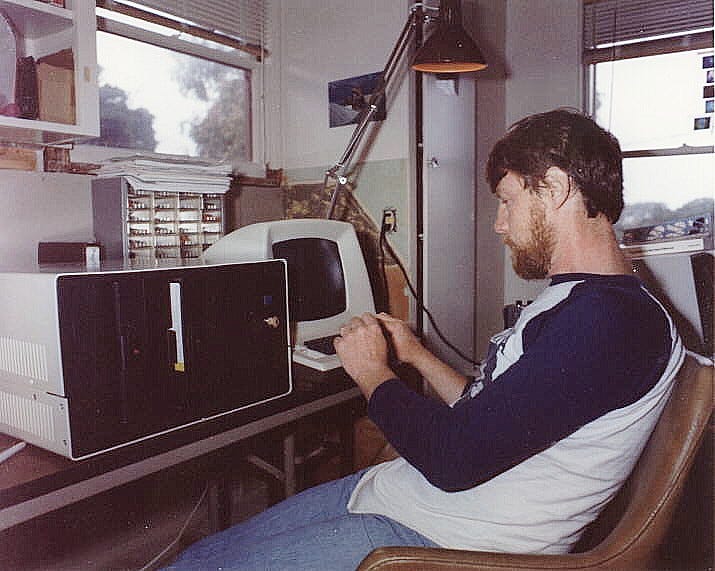
Gary in 734 Lighthouse Avenue. Photo: John Pierce
One Friday afternoon, Gary called the engineering staff together and announced that he would give them all a raise over the weekend. On Monday, when they returned to work, contractors began raising the building to make room in the basement for a new Digital Equipment Corporation VAX 11/750 computer system. After several weeks, supported by heavy wooden beams and house jacks, the engineers' desks were five feet higher.
By 1983, DRI's annual sales reached $45 million. The company employed over 500 people, including more than 100 engineers, and had expanded into another building at 160 Central Avenue, which today houses the Monterey Bay Aquarium's offices.
In 1980, IBM established a new business division in Boca Raton, Florida, to develop a desktop computer for the mass market. To get the IBM PC, as it became known, to market as quickly as possible, they used commercially available components, including an Intel microprocessor chip. Bill Gates knew Gary from early discussions about merging their companies and setting up shop in Pacific Grove, so when an IBM procurement team visited Microsoft to license the BASIC interpreter program, he referred them to DRI for an operating system.
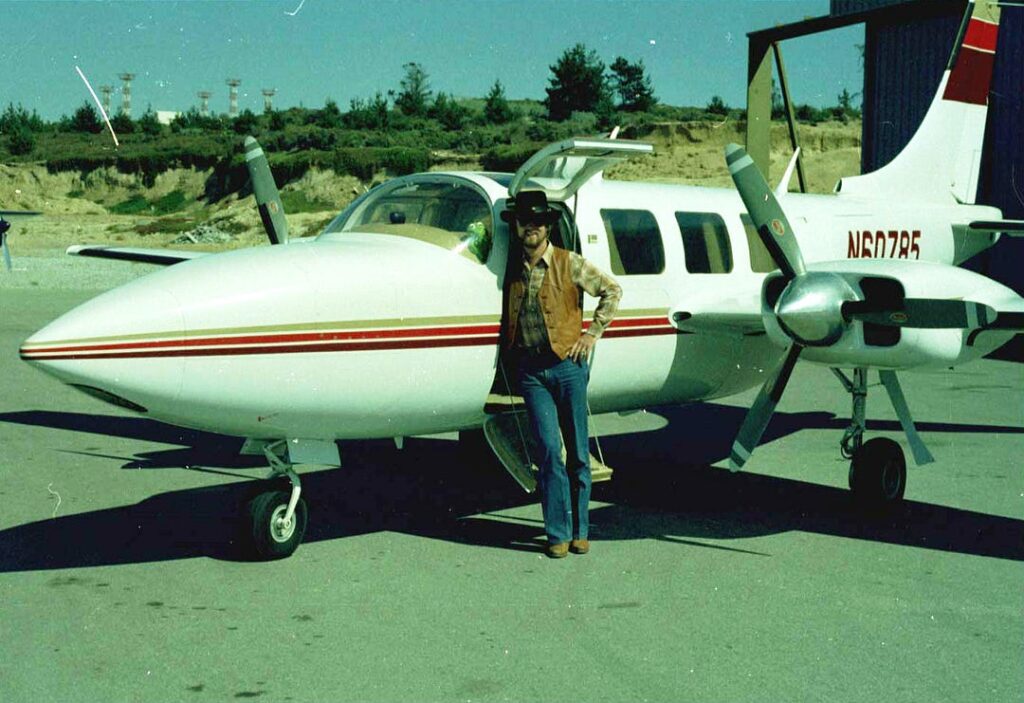
Gary at Monterey Airport with his Piper Aerostar. Photo: Tom Rolander
When the IBM team arrived in Pacific Grove, they met in the morning with Dorothy and DRI attorney Gerry Davis to agree on the terms of a non-disclosure agreement. Gary, who had flown his aircraft to Oakland to meet an important customer, returned in the afternoon, as scheduled, to discuss technical matters. IBM wished to purchase CP/M outright, whereas DRI sought a per-copy royalty payment in order to protect its existing base of business. The meeting ended in an impasse over financial terms, but Gary believed they had essentially agreed to do business.
Kildall tried to renew the negotiations a couple of weeks later. IBM did not respond because, in the meantime, Bill Gates purchased an OS from Seattle Computer Products that was written to emulate the look and feel of CP/M. He then sold a one-time, non-exclusive license to IBM, which used the designation PC DOS. With great foresight, he retained the right to license the product to others as MS-DOS.
When Gary learned of this transaction, he threatened IBM with a lawsuit over what he believed was an illegal copy of CP/M. IBM responded by agreeing to fund DRI to adapt CP/M for the PC and to make both brands of OS available to customers. With CP/M's reputation and enhanced features, DRI believed customers would opt for the better product.
IBM announced the PC on August 12, 1981, but with the PC-DOS list price set at $40 versus $240 for CP/M, most customers simply chose the former as the lower-cost option. Attorney Gerry Davis recalled that "IBM clearly betrayed the impression they gave Gary and me."
DRI continued to thrive for several years with a multi-tasking operating system for the IBM PC-XT and a host of new products. The company also introduced operating systems with windowing capability and menu-driven user interfaces years before Apple and Microsoft.
At its peak, DRI employed over 500 people and opened operations in Asia and Europe. However, by the mid-1980s, in the struggle with the juggernaut created by the combined efforts of IBM and Microsoft, DRI had lost the basis of its operating systems business.
Dispirited, Gary, who never relished the responsibility of managing a large company or displayed the cut-throat business acumen of a Gates, sold the company to Novell Inc. of Provo, Utah, in 1991. Ultimately, Novell closed the California operation and, in 1996, disposed of the assets to Caldera, Inc., which used DRI intellectual property assets to prevail in a lawsuit against Microsoft.
In other pursuits, Gary founded KnowledgeSet with his friend and DRI VP of engineering, Tom Rolander, where they created the first CD-ROM encyclopedia for Grolier.
In an oral history for the Computer History Museum, Brian Halla, Intel's technical liaison to DRI, recalls that Gary "showed me this VAX 11/780 that he had running in his basement, and he was so proud of it, and he said, 'I figured out a way to have a computer generate animation,' and he said, 'Watch this. And he runs a demo of a Coke bottle that starts real slowly and starts spinning, and so as maybe several months went by, he lost interest in this, and he sold his setup to a little company called Pixar.'"
Kildall continued to innovate after selling DRI. He moved to Austin, Texas, where he founded Prometheus Light and Sound to explore wireless home networking technology and participated in charitable work for pediatric AIDS.
Gary Kildall died in 1996 at age 52 following an accident in Monterey. His ashes are buried in Seattle, the hometown he shared with Bill Gates. Dorothy McEwan Kildall purchased the Holman Ranch in Carmel Valley and served on many community boards, including the Heritage Society of Pacific Grove. She died in 2005.
In 1995, the Software and Information Industry Association presented Gary Kildall with a posthumous Lifetime Achievement Award, citing eight significant areas in which he contributed to the microcomputer industry.
In an obituary published in the Microprocessor Report in 1994, his friend, the late John Wharton, commented, "I don't think Gary ever really begrudged Bill Gates his business success or his personal fortune. … what I think Gary wanted most was to share his excitement and enthusiasm for computers and technology with others."
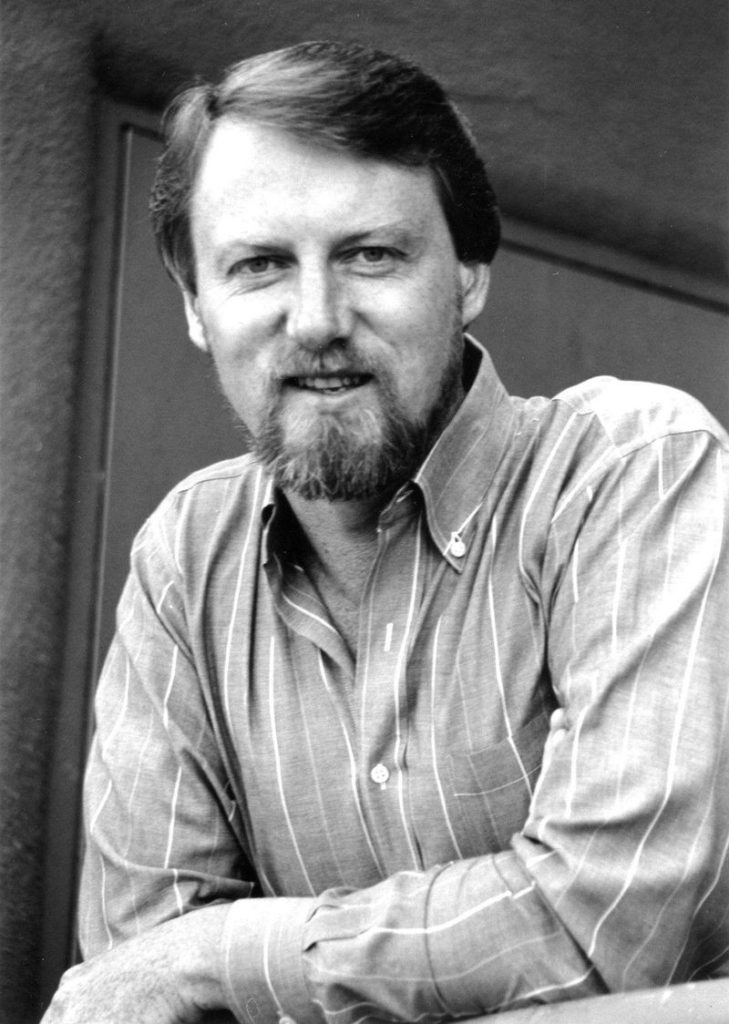
Gary Kildall in 1988 Photo: Copyright Tom O'Neal, Carmel Valley, CA
On April 25, 2014, the Institute of Electrical and Electronic Engineering, "The world's largest professional association for the advancement of technology," installed a bronze IEEE Milestone in Electrical Engineering and Computing plaque outside the former DRI headquarters at 801 Lighthouse Avenue. The Milestone program honors important events in electrical engineering and computing. Achievements such as Thomas Edison's electric light bulb, Marconi's wireless communications, and Bell Labs' first transistor are recognized with plaques in appropriate locations.
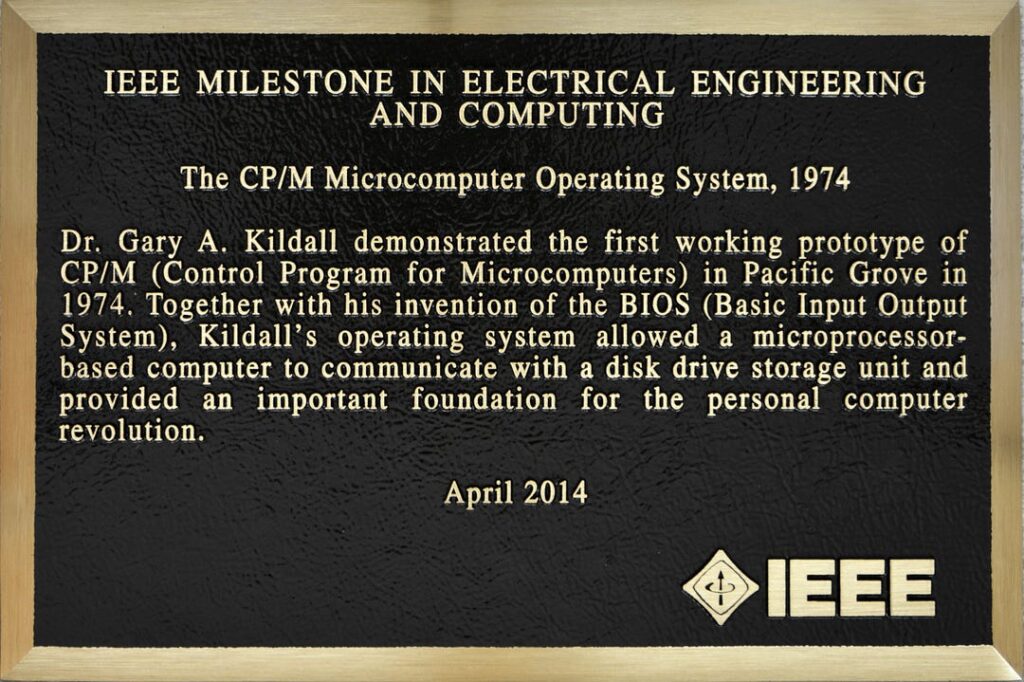
The citation reads: "Dr. Gary A. Kildall demonstrated the first working prototype of CP/M (Control Program for Microcomputers) in Pacific Grove in 1974. Together with his invention of the BIOS (Basic Input Output System), Kildall's operating system allowed a microprocessor-based computer to communicate with a disk drive storage unit and provided an important foundation for the personal computer revolution."
In 2017, US Navy dignitaries, friends, family, and peers gathered to celebrate the dedication of the Gary A. Kildall Conference Room on the Naval Postgraduate School campus in Monterey. The ceremony included the installation of a duplicate of the IEEE plaque in the conference room.
Despite this wide recognition of his technical accomplishments, Gary's legacy remains mired in a tangle of myths and conspiracy theories. The most persistent being driven by a 1982 comment attributed to Bill Gates and published in the London Times newspaper that "Gary was out flying when IBM came to visit, and that's why they did not get the contract."
The former editor of the Times, Harold Evans, atoned for that story in a PBS documentary and his book They Made America: Two Centuries of Innovators from the Steam Engine to the Search Engine. The subtitle of the chapter on Gary, "He saw the future and made it work. He was the true founder of the personal computer revolution and the father of PC software," offers a sympathetic telling of the life and times of the entrepreneurial genius who helped give birth to the PC operating system 50 years ago this year.
Comments in quotes in this article without source attribution are from Gary's unpublished draft of Computer Connections: People, Places, and Events in the Evolution of the Personal Computer Industry, written in 1993. The Kidall family has authorized the online publication of extracts from this memoir in the blog Gary Kidall: In His Own Words.
The Computer History Museum has also made the source code of several early releases of CP/M available for non-commercial use.
A search for "Kildall" in the CHM collection catalog yields 45 records comprising objects, documents, and images, including a video of the 2014 CP/M IEEE Milestone Dedication event.